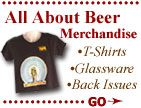
| ||||
| AAB Departments |
| ...Beer Features |
| ...Beer Talk |
| ...Pull Up A Stool! |
| ...What's Brewing |
| ...Beer Travelers |
| ...Stylistically Speaking |
| ...Beer & Food |
| ...Homebrewing |
| ...Collectibles |
| ...Marketplace |
| Beer Lovers' Resources |
| ...World Beer Festival |
| ...Brew Cruise Info |
| ...AAB Merchandise |
| ...AAB Bookstore |
| ...Beer Links |
| About the Magazine |
| ...Subscription Info |
| ...Retail the Magazine |
| ...Advertising Info |
| ...Contact AAB |

|
Bottling your beer
A few days after fermentation is complete, you are ready to bottle your beer. Hereâs a checklist of the things youâll need on bottling day.Equipment
Measuring cup, 1 cup or larger capacity.
Small pan for boiling water
Racking or bottling bucket (plastic)
Racking cane and transfer tubing
Bottle filler
Hydrometer
Supplies
55 to 60 twelve ounce bottles and bottle caps
Bottle capper
² cup of dry malt extract or priming sugar (purchased from your homebrew supply shop.)
Overview
First, if you havenât used the bottle capper before, experiment with it a bit on an empty bottle or two. Once youâve got the hang of it, just use a bottle opener to remove the practice caps from the empty bottles. (Just think, youâll soon be doing that to bottles of beer that you brewed yourself!)
Now, hereâs the overview of the bottling process. First, weâll transfer the beer from the fermenter to the racking bucket in order to separate it from the spent yeast and other debris. Then weâll add just a bit of sugar to the beer so that it will carbonate in the bottle. After that, we are ready to fill the beer into the bottles and cap them.
Throughout this process, we want to minimize splashing and aeration of the beer as this can have undesirable flavor effects. This isnât a huge deal, but just remember that "quiet is cool" when dealing with fermented beer.
Sanitize the equipment and bottles
The first step in bottling is cleaning. All of the equipment that will touch the beer -- no matter how briefly -- must be cleaned and sanitized as described in our section on Sanitation. In addition, all the bottles must be cleaned and sanitized as well. (Although, if you are using new bottles, you can usually go straight to the sanitizing step.)
Racking the beer
"Racking" is a brewers term for transferring or moving the beer from one vessel to another. In this case, weâll rack the beer from the fermenter to the racking bucket using the sanitized racking tube and cane. (If you havenât already, see the note in Sanitation about how to fill the tube with water.)
To achieve the racking, weâll use the magic of siphon action to move the beer. Put the fermenter on the counter with the racking bucket below it on a chair set immediately in front of the counter. (Alternately, you can put the fermenter on a chair and the racking bucket below it on the floor.)
Now put the racking cane in the fermenter so that it rests against the bottom on the far side - away from the racking bucket - and leaning forward at an angle to rest on the front edge. The tube end goes in the racking bucket itself and should rest against the bottom as well. If it does not reach the bottom, use a phone book or a small box to raise the level of the racking bucket until it does. Now you are ready to transfer. Release the clamp on the hose so that the beer flows into the racking bucket. To minimize splashing at the beginning of racking, you may want to tip the racking bucket to keep the tube end submerged in beer.
Siphon power depends upon the level of the liquid in the bottom container being lower than the level of liquid in the top container. Keep this in mind and adjust things during the racking process if you need to.
Near the end of racking, you will want to tip the fermenter back, away from the front of the counter. This will keep the end of the racking tube submerged in beer for as long as possible and minimize beer loss. Then, as the thimble on the racking cane is about to emerge from the last of the beer, close the clamp on the tube end so that the racking tube and cane remain filled with beer.
You are now ready to prime the beer.
Priming
Right now your beer is flat -- it has no carbonation. Rather than using some mechanical or industrial process to carbonate it, we will do this naturally using the fermentation power of the yeast.
When yeast ferment sugar, they turn it into alcohol and carbon dioxide. The carbon dioxide produced by fermentation inside a bottle dissolves into the beer and thereby carbonates it. Even if your beer looks perfectly clear when you rack it, it still contains enough yeast to carbonate your beer. All we have to do is to add a measured amount of sugar before bottling.
The standard quantity of sugar used for priming 5 gallons of beer is ² of a cup. You must use corn sugar (also known as dextrose) or perhaps dry malt extract for this purpose. You can not use ordinary table sugar.
Measure the sugar into your measuring cup and then mix it with 1/3 to 2/3 cup of boiling water. This will sanitize the sugar solution. Once this is prepared, you can pour it into the beer in the racking bucket. Next, take the racking cane and gently stir the beer for 30 seconds or so to mix in the sugar solution. Remember, no splashing!
Bottling
First set the racking bucket on the counter or a chair and make a work area for yourself at a lower level so that siphon power will move the beer for you.
Next, arrange the bottles nearby. I usually leave them in the case boxes to make them easier to handle.
With the racking tube clamp still closed, affix the bottle filler to the end of the tube. Now use the empty priming sugar cup to practice. With the racking cane in the beer and the bottle filler in your priming cup, open the clamp on the racking tube. Then press down on the bottle filler so that beer flows into the cup. If you want, put 6 ounces or so of beer into the cup and use this to measure the gravity with your hydrometer.
You are now ready to fill those bottles!
Insert the bottle filler into a bottle and press it against the bottom of the bottle to start the flow of beer. Continue until the liquid level reaches the very top of the bottle. As soon as you release the pressure on the filler the flow of beer will stop. Then, as you remove the filler from the bottle, the level of beer will drop. When the filler is removed, the beer will be about two inches from the top of the bottle.
At this stage, I generally find it easiest to fill a whole case of bottles before I begin capping. There is no rush to get the capping done as long as it happens within an hour or so of when you add the priming sugar to the beer.
As you fill, keep an eye on the level of beer in the racking bucket. When it starts to get low, tilt it so that you can draw out most of the beer without sucking up any air.
Once the beers are filled and capped, they need to rest for two weeks to a month before theyâll be ready to drink. Ideally, you will keep them at room temperature (65 to 75 deg F) during this time so that the priming fermentation and aging processes can take place properly.
I know that it is hard to wait, but patience is usually rewarded with better tasting beer. (Of course to prove this, you might have to taste one bottle after two weeks.) If you are that anxious, go ahead and make another batch of beer so that youâll have a steady supply coming once you taste the first batch.
By the way, this is the stage where you could run into that old bugaboo of homebrewing, the exploding bottle. Mind you, it is quite rare -- I have produced more than 5,000 bottles of homebrew and I can only remember two that ever exploded. More than likely, these two happened to be in weak or cracked bottles that couldnât handle the relatively mild pressure exerted by natural carbonation. Nonetheless, it is a good idea to keep your bottled beer stored inside cardboard case boxes with the lids closed. That way, if one does happen to explode the flying glass will be contained inside the box.
After the beers have aged, throw a couple of bottles in the refrigerator to chill them down. Open and enjoy.
Labeling your brew
If you drink all of one batch before you make another, youâll never have any need to label your beers. But few people operate that way, so some system of labeling comes in handy.
The easiest is to take a china marker and mark a batch number on the top of each bottle. If you want more than that, you can get some of the small round self-adhesive labels sold at office supply stores and affix them to the tops of the bottles. With these, you can write out some additional information including the style, bottling date, etc. if you want to.
Another fun thing to do with your homebrew is to have some labels made up to go on the front of the bottle. If you are artistic or have some skill with a computer, this can be easy to do. Homebrew shops often offer gummed paper that is pre-cut or perforated to produce normal bottle-sized labels. But whatever you do, remember the three most important rules of bottle labels: 1) Have fun, 2) Go wild, and 3) Show off.
-- Ray Daniels










